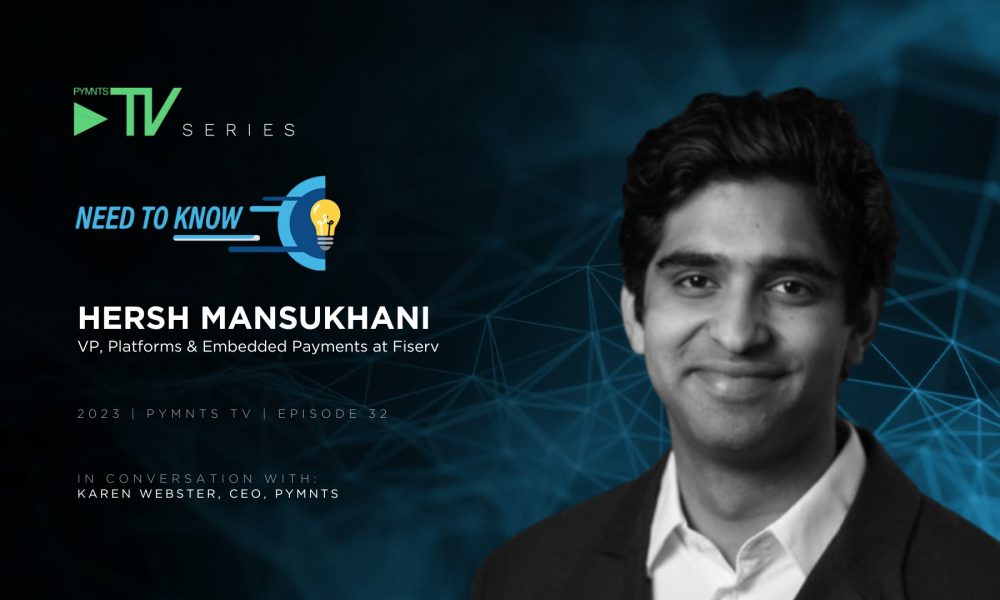“We’re still in the early innings” of embedded payments, Hersh Mansukhani, vice president of platforms and embedded payments at Fiserv, told PYMNTS’ Karen Webster.
“The platformization of the world is occurring, and software is getting into places where it never was before,” he added.
There’s value and scale to be realized for traditional retailers looking to establish online platforms that can onboard sellers — some of them seasonal — and shape new, digital experiences for end customers. Digital, embedded transactions are transforming industries as diverse as rental markets and logistics, which have traditionally been offline and now are pivoting toward omnichannel transactions.
But complexities and risk abound in the bid to bring payments more fully into the business.
As marketplaces take shape, Mansukhani said, the revenues a retailer makes from payments might at some point outpace the software or core services sold to merchants they onboard. The closer they get to the actual payments processing and merchant contract signing, the more margin there is to be made. That’s especially true for online models that seek to provide sellers with a single experience that’s serviced by multiple enablers all at once, akin to a “one-stop shop.”
Much depends on strategy, he said, and whether building a brand with sellers entails being a “front-end provider” with the infrastructure to handle customer inquiries directly, or whether the overarching aim is to exist as an application programming interface (API) integrator or facilitator on the back end. There’s the chance to embed payments on both sides of that equation.
“You don’t have to become a payments company to offer payments as a product,” he contended.
For retailers establishing their digital marketplaces, some existential questions must be answered. There’s an examination of tech stacks and back-end operations that must take place, and an evaluation of whether there’s a need — or even an ability — to replace current billing practices. Retailers/marketplaces must mull the agreements they will have to strike with providers that service sellers on the marketplace and how to account for it all behind the scenes.
The transition to embedded payments compels companies to understand how they are servicing the “entire chain” of command as it relates to transactions, he said, and where there’s a chance to consolidate some of the billing, reporting and payment systems — in effect, streamlining money movement.
“The more intermediaries you have in the value chain, the less flexibility you can offer,” Mansukhani added.
Different platform models demand different strategies depending on whether a retailer is in the background or operates front and center, he said. A marketplace might allow sellers and buyers to come together directly, or sellers may transact with the brand’s platform or marketplace itself, which in turn sells to the customer. Platforms might operate by splitting payments among many sellers and the marketplace where payments are collected from customers.
The Key Considerations
Mansukhani highlighted some considerations for businesses in a four-part framework: “How are you onboarding? How are you managing credit risk and exposure to that risk? How are you managing the reporting? And how are you funding everyone?”
Compliance is top of mind, said Mansukhani, who added that “once you become a platform and you facilitate money movement on behalf of others, there are a lot of responsibilities that you must take on.”
Many retailers, particularly traditional companies that are relatively new to the marketplace model, may not be as cognizant as other firms that have robust, sizable compliance teams that undergo monthly training on anti-money laundering (AML) regulations. Against that backdrop, he said, by partnering with providers like Carat from Fiserv, businesses can get help with “AML-as-a-Service, Program Standardization-as-a-Service and Credit Risk-as-a-Service.”
By breaking down the silos and with embedded payments, he said, “you’re not just making money from payments processing. You’re making money from the ability to bring really complex things together and make them look simple. There’s significant value and margin there.”
Read the full article here














